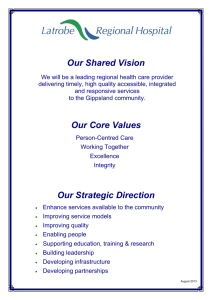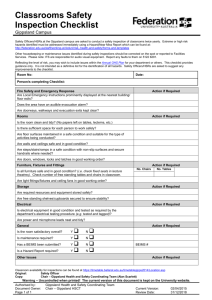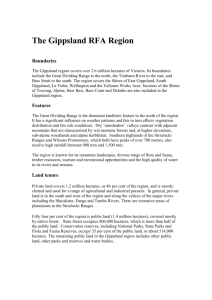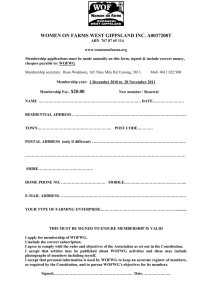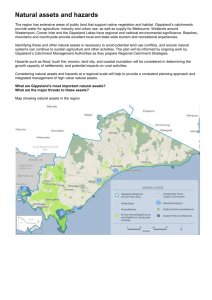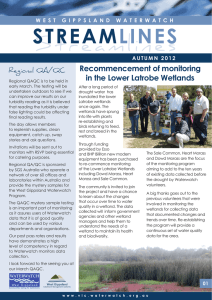Stream Lines FOCUS on Gippsland lakes Gippsland Waterwatch Newsletter Gippsland
advertisement
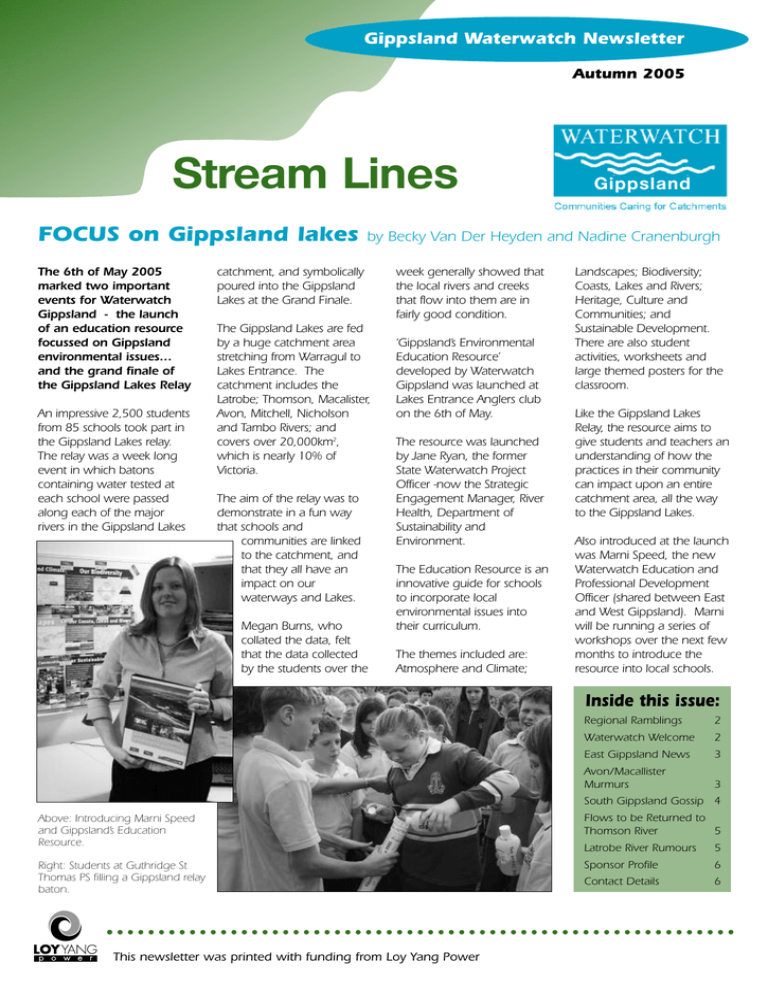
Gippsland Waterwatch Newsletter Autumn 2005 Stream Lines FOCUS on Gippsland lakes The 6th of May 2005 marked two important events for Waterwatch Gippsland - the launch of an education resource focussed on Gippsland environmental issues… and the grand finale of the Gippsland Lakes Relay An impressive 2,500 students from 85 schools took part in the Gippsland Lakes relay. The relay was a week long event in which batons containing water tested at each school were passed along each of the major rivers in the Gippsland Lakes Gippsland by Becky Van Der Heyden and Nadine Cranenburgh catchment, and symbolically poured into the Gippsland Lakes at the Grand Finale. The Gippsland Lakes are fed by a huge catchment area stretching from Warragul to Lakes Entrance. The catchment includes the Latrobe; Thomson, Macalister, Avon, Mitchell, Nicholson and Tambo Rivers; and covers over 20,000km2, which is nearly 10% of Victoria. The aim of the relay was to demonstrate in a fun way that schools and communities are linked to the catchment, and that they all have an impact on our waterways and Lakes. Megan Burns, who collated the data, felt that the data collected by the students over the week generally showed that the local rivers and creeks that flow into them are in fairly good condition. ‘Gippsland’s Environmental Education Resource’ developed by Waterwatch Gippsland was launched at Lakes Entrance Anglers club on the 6th of May. The resource was launched by Jane Ryan, the former State Waterwatch Project Officer -now the Strategic Engagement Manager, River Health, Department of Sustainability and Environment. The Education Resource is an innovative guide for schools to incorporate local environmental issues into their curriculum. The themes included are: Atmosphere and Climate; Landscapes; Biodiversity; Coasts, Lakes and Rivers; Heritage, Culture and Communities; and Sustainable Development. There are also student activities, worksheets and large themed posters for the classroom. Like the Gippsland Lakes Relay, the resource aims to give students and teachers an understanding of how the practices in their community can impact upon an entire catchment area, all the way to the Gippsland Lakes. Also introduced at the launch was Marni Speed, the new Waterwatch Education and Professional Development Officer (shared between East and West Gippsland). Marni will be running a series of workshops over the next few months to introduce the resource into local schools. Inside this issue: Regional Ramblings 2 Waterwatch Welcome 2 East Gippsland News 3 Avon/Macallister Murmurs 3 South Gippsland Gossip 4 Above: Introducing Marni Speed and Gippsland’s Education Resource. Flows to be Returned to Thomson River 5 Latrobe River Rumours 5 Right: Students at Guthridge St Thomas PS filling a Gippsland relay baton. Sponsor Profile 6 Contact Details 6 This newsletter was printed with funding from Loy Yang Power Calender of Events West Gippsland QA/QC Refresher Training Coming up - Facilitators will provide details “Gippsland’s Education Resource” – workshops for teachers 14th June – 18th August – Contact Marni Speed QA/QC Day – Orbost 20th June – contact Megan Burns QA/QC Day – Mallacoota 21st June – contact Megan Burns QA/QC Day – Bairnsdale 23rd June - contact Megan Burns QA/QC Day – Bonang 24th June – contact Megan Burns REGIONAL RAMBLINGS by Nadine Cranenburgh & Megan Burns In the west…. education package (see front page). This is my first newsletter with the Waterwatch team and it has been a busy three months. As well as joining Waterwatch, I have also relocated to Leongatha from the Mornington Peninsula, where I was working in the Royal Australian Navy – so lots of big changes! Other exciting news is that we now have two three dimensional catchment models, which will help us to explain how our catchment works (a picture saves a thousand words). Louise has had a lovely baby boy, Nicholas, and we were glad that she could make it to the launch of the There is also a new Waterwatch interpretive trail at the Heyfield Wetlands Discovery Centre, with great artwork and information galore, so if you are in the area drop in and have a look… You may also be aware that a 2 day/week Waterwatch position was advertised recently, this due to my position changing. For 2 days/week I will be project managing the ‘Gippsland Lakes Communications Steering Committee’, therefore a new person will be appointed to cover the two days I will not be with Waterwatch. You will be informed as soon as the new person is appointed; I am hoping this will happen in the next month or two. In the east… Did You Know . . . The East Gippsland Catchment Management Authority has moved from the office in Nicholson St, Bairnsdale to the new DSE/DPI building at the top of town (574 Main St). So when you come in to visit me remember to come to the new building, my direct line is 5150 3576 and the main reception number is 5152 0600. The postal address is still the same P.O Box 1012 Bairnsdale 3875. Left: Josh Young (modeller) and the South Gippsland Catchment model Above: Nadine Cranenburgh in the Waterwatch office Waterwatch Welcome Page 2 Stream Lines Autumn 2005 And our newest team member is… developed “Gippsland’s Environmental Education Resource – Linking our catchments and estuaries to the coast” Hi! My name is Marni Speed and I started with Waterwatch as an Education and Professional Development Officer at the beginning of May. I am originally from Mirboo North and am living in Paynesville after recently moving back to Gippsland from Albury where I worked as a coordinator at a volunteer resource centre. My role is to run a series of professional development sessions with teachers throughout the Gippsland Lakes catchment based on the newly I have a background in natural resource management and education and hope to put both areas of experience to good use in the coming months. EAST GIPPSLAND NEWS by Megan Burns and Josh Puglisi The East Gippsland program has been on the go with both the community and education programs in the last few months. Check out the front article about our Gippsland Environmental Education Resource and the Gippsland Lakes Relay. I ran a number of volunteer information and macro training sessions around the region, although not all sessions had high attendance I am appreciative of the volunteers and the new faces for making the time to attend. For those who missed the sessions there were a number of important issues discussed regarding water quality monitoring. Waterwatch Victoria has worked hard to strengthen partnerships with all involved with the Victorian Water Resources Data Warehouse (www.vicwaterdata.net check this site out). What this means for us is that the data that you collect could end up on this website. This is a step forward for Waterwatch, our data will be used in the same way that scientific data analysed in a laboratory would be used in major reports on the health of our waterways. The way you collect your water sample should not change too much because you are already following procedures set by Waterwatch. The only difference is in the way you record the calibration of your instruments, which will be added to your data sheet instead of on a separate sheet. There are a number of ‘Standards’ at which you can collect samples, depending on which one you want to be in will depend on whether your data will end up on the website. If you have any questions about this information please do not hesitate to call me on the new number. Community taking time to sample and ID bugs around the region AVON/MACALISTER MURMURS by Greg Gilbert Creeks across the region are looking like they were back in 2001; with Boundary, Blind Joe’s, the Blackall, Back, the Eaglehawk, Fel’s and MacFadgen’s creeks all again basically dry. With an El Nino this week stated to be at greater than a 50% probability, larger morass areas may well dry out totally too; many areas in Dowd’s Morass already devoid of water. Loch Sport, Airly, Seaspray and Wurruk primary schools have been out looking at macro invertebrates with Waterwatch. Lake Victoria, a channel, the Merriman’s Creek and a shallow billabong their respective sites for activities. Gippsland Grammar Aquatic Science students also went to discover the intricacies of the Sale Common, with water this week visibly lower at 20 cm. The Gippsland Lakes Relay could not go without some mention in this region with 25 schools locally taking part. A wonderful enthusiasm was evident among all students who tested multiple site samples for turbidity and salt. Some visited creeks, some collected at the Ports of Maffra and Sale; one school had a BBQ and a remarkable Lake presence with fishing, sand castles, boat rides and as many as 20 water samples tested for salt interest and actual use. Thankyou to everyone involved in the Gippsland Lakes Relay. Nutrient concentrations in the Thomson River are very high again at this time of the year, while the Macalister River looks in much better shape than it has been for a number of years (due to good summer support rains). The Thomson is the major receiving river for many irrigation returning streams in the northern MID; Boggy Creek, the Heyfield Extension, the Back Creek, and the Gippsland No. 6 Drain. The lower Macalister River has Newry Creek and the Newry drains upstream of Maffra that are partially diverted to channel systems at Airly, Bundalaguah, Cobains and Sale. Downstream of Maffra return systems of the Macalister River that reach the Thomson River are the Serpentine and the Riverslea drains and all of these have had a combined effect on the Thomson River. While the Latrobe River at this time of year has had 0.045 uS/cm of reactive phosphorus; the Thomson has had 0.18 uS/cm; 4 times its concentration. Don Ripper receives Gippsland Lakes Relay Baton at Port of Sale. Page 3 Stream Lines Autumn 2005 South Gippsland Gossip by Tanya Cowell The Environment Protection Authority (EPA) is conducting a dairy effluent audit in the South Gippsland area, starting with the Corner Inlet catchment. So far 800 dairy farms have been audited by EPA officers across the state. A recent Landcare field day in Toora saw farmers, the EPA, Department of Primary Industry, South Gippsland Water and Waterwatch representatives share their knowledge and concerns about dairy effluent management. The topics discussed included the cost and upkeep of new systems, effluent system options and the effect that unsatisfactory systems may have downstream. Wayne Bath from the EPA said of the process that all up 61 dairy farms in the Toora/Franklin and Stockyard creek catchments were audited, 16 were issued with Minor Works Pollution Abatement Notices. A further 30 farms were sent warning or risk letters. Therefore 46 farms had problems with effluent management out of 61 farms which equates to about 75% of farms in the area being required to review their effluent management practices. Mr Bath has observed that most farmers have been happy to make the necessary improvements. Tanya Cowell speaking at a dairy effluent field day in Toora. Although the initial outlay of upgrading effluent systems may be viewed as a considerable expense, the EPA point out that most farms have huge fertiliser bills and irrigating with effluent can make a considerable saving also. It must be remembered that there are many nutrient sources that influence loads in rivers; dairy effluent and fertilizer usage being only two of them being focussed on at the moment. Nutrients are a priority for EPA because nutrient loss to surface and groundwaters is one of the major causes of pollution in Victoria’s waters. It leads to lower water quality in creeks, rivers and oceans, and can affect beneficial uses, such as recreation and farming downstream. Other sources of nutrients include stormwater runoff from towns, erosion and presence of exotic plants such as the willow. Waterwatch is also concerned about nutrients flowing down our rivers altering the natural state, and thus affecting the biodiversity of the creeks, rivers, estuaries and oceans. The efficiency of nutrients can be worked out by comparing inputs and outputs. With best practice management more than 80% of nutrients can be used productively and converted into milk, stock and crops. Inputs – Nutrients are imported onto the farm as fertiliser and feed, which contain the major ingredients needed to grow pasture – phosphorus, nitrogen and potassium. What are Environmental Flows? There are many demands on rivers today, from irrigators, water authorities and domestic users. When too much water is taken from river, its flow is affected. Natural flows in a river can vary considerably with changes in season and rainfall- and this variation plays an important role in river ecology. For example, high flows can stimulate fish breeding and low flows (or base flows) can maintain water quality in pools in summer. When managing the water allocations taken from a river, it is important to remember that a share of the flow is needed to keep the river in good health. The environmental flow of a river is that share which is allocated to the river to maintain its ecology, and is not available for extraction. The State Government has made a commitment to return environmental flows to the Thomson and Macalister Rivers (see article on page 5) Page 4 Stream Lines Autumn 2005 Outputs – These nutrients are exported from the farm in milk, crops and stock. Losses – Nutrients can also be lost from the farm in water that runs off the surface or leaches through soil and Nitrogen can be lost to air. Farms should aim to lose less than 20% of their nutrients. Survey results show that many farmers could tap into more value from the fertiliser they are already applying by cutting losses. (Source : EPA website: www.epa.vic.gov.au/business_sustainability/dairy.asp) Flows to be returned to Thomson and Macalister by Penny Neumann In a first for Gippsland, the Victorian Government has made a firm commitment to restoring environmental flows, by providing the Thomson River with a legal share of water from the Thomson Dam. exotic vegetation (willows, blackberry etc), fencing to exclude stock from the rivers and revegetation with indigenous native plants. Over the next ten years 18,000 ML per year and 7,000 ML per year will be returned to the Thomson and Macalister rivers respectively, to restore environmental flow regimes and improve the health of the rivers. Return of environmental flows will commence in October 2005, with a comprehensive monitoring program implemented to identify changes in water quality, fish and macroinvertebrate population structures, vegetation and channel form. There are currently 24 Waterwatch sites within the Thomson and Macalister catchments monitoring various water quality parameters, with many of these sites filling gaps in coverage of the Gippsland Regional Water Monitoring Partnership water quality sites. In addition to these volumes of water, Government has also committed to funding various on-ground projects to enhance the health of the rivers, such as removal of On-going community involvement in the monitoring program for the Thomson and Macalister Rivers is important, and there are a range of ways to be An environmental allocation for the Macalister River will also be available in 2006. Latrobe River Rumours Traralgon Creek NEIP Moves On… The Traralgon Creek Neighbourhood Environment Improvement Plan (NEIP) has moved a step further towards its ultimate objective with the appointment of a Project Officer, Mike Answerth, to co-ordinate the project and the establishment of a Steering Committee to oversee the development of the final plan. On Wednesday 11 May 2005, the first of several proposed Community meetings took place in Traralgon with more than thirty interested people attending. Out of this gathering several relevant issues were identified and a number of attendees indicated their willingness to be part of a Steering Committee to guide the development of the plan. He said that Latrobe City was committed to ensuring that there was strong community involvement in this Neighbourhood Plan and that the result would be an improved Traralgon Creek that would benefit all citizens. Willow removal along Traralgon Creek Stream Lines Autumn 2005 Waterwatch staff and the Thomson Macalister Environmental Flows Project Manager, Penny Neumann, are working together to raise community awareness of the project and encourage involvement in the monitoring program. If you are interested in being involved in the Thomson Macallister Environmental flows project please contact Penny at the West Gippsland Catchment Management Authority on 5175 7800. See Page 4 for more information on Environmental Flows… by Tammy Dawson & Mike Answerth Speaking at the public meeting, Cr Bob Smith said that he was impressed by the enthusiasm, level of interest and ownership of those at the meeting. Page 5 involved, including: Establishment of photo points; Physical habitat monitoring; Oral history surveys; Macroinvertebrate collection; and Water quality monitoring. Kylie Debono of the West Gippsland Catchment Management Authority, reported to the meeting on the continuing programme of removing exotic vegetation from the creek which has now seen willows removed from the stream along many kilometres in Traralgon South as well as between Shakespeare Street and the Princes Highway, in Traralgon City. In 2004-05, $375,000 was spent on this activity and a further $390,000 has been allocated for the 2005-06 financial year. It is eventually envisaged that 80% of the creek area will be revegetated and fenced off to prevent damage to banks and maintain water quality. Among ideas advanced at the community meeting were the possibility of public tours of the creek to inspect improvement works, involvement of local businesses in litter reduction programmes and a weed reduction campaign. Waterwatch is keen to involve community water quality monitoring as part of the NEIP. Anyone who would like to have input into the NEIP can contact Mike Answerth of Latrobe City on 1300 367 700 or email mikean@latrobe.vic.gov.au Sponsor profile: Gippsland Water Gippsland Waterwatch Communities Caring for Catchments Contacts: Nadine Cranenburgh West Gippsland Regional Coordinator 16 Hotham St, Traralgon 3844 Ph: (03) 5175 7800 Email: nadinec@wgcma.vic.gov.au Tammy Dawson Latrobe Facilitator 16 Hotham St, Traralgon 3844 Ph: (03) 5175 7800 Email: tammyd@wgcma.vic.gov.au Tanya Cowell South Gippsland Facilitator P.O. Box 99, Leongatha 3953 Ph: (03) 5662 4555 Email: tanyac@wgcma.vic.gov.au Greg Gilbert Sale region Facilitator 906 Dolphin Av, Golden Beach 3851 Ph: (03) 5146 3217 Email: ggil@netspace.net.au Marni Speed Education & Professional Development Officer 16 Hotham St, Traralgon 3844 Ph: (03) 5175 7800 Email: marnis@wgcma.vic.gov.au -----------------------------------------------Megan Burns East Gippsland Regional Coordinator P.O. Box 1012, Bairnsdale 3875 Ph: (03) 5153 0462 Email: mburns@egcma.com.au Josh Puglisi Community Education & Projects Coordinator P.O. Box 260, Orbost 3888 Ph: (03) 5161 1222 Email: egwaterwatch@datafast.net.au Company: Gippsland Water How long sponsoring Waterwatch? A proud sponsor of Waterwatch since 1993. Interesting statistics about the company: Gippsland Water’s geographic region stretches from Drouin in the west to Stratford in the east and from Mirboo North in the south to Rawson and Briagolong in the North. The region supports a population base of about 130,000 people. Of the 15 non-metropolitan water authorities, Gippsland Water is the largest water authority in terms of total water supplied and volume of wastewater collected. Gippsland Water’s geographical location makes us unique in that we are responsible for: • Helping to protect the Moondarra water catchment • Providing raw water to several major industries of state and national significance • An urban water and wastewater reticulation and retail sale service • Collecting and disposing of regional domestic and industrial wastewater (70% of total water supplied is to major local industry) • A significant solid and liquid prescribed waste treatment and storage business • Managing the second largest closed cattle herd in Gippsland Gippsland Water manages 19 Water Treatment Plants and 13 Wastewater Treatment Plants in the region. We Key Stakeholders employ approximately 200 staff and our main office is located in Traralgon. Gippsland Water has two ocean outfall pipelines which are the saline water outfall pipeline (SWOP) and the Delray Beach Ocean Outfall. These pipelines both operate in accordance with our EPA waste discharge licences and we continue to meet the requirements of these licences. What is Gippsland Water doing for the environment? Gippsland Water is a key player in the management of natural resources within the central Gippsland Region. We demonstrate a commitment to the environment, our stakeholders and our customers with the aim of sustaining and improving our natural assets for future generations. Gippsland Water’s purpose is to provide high-quality water, wastewater and waste recovery services that secure social, environmental and economic benefits for Central Gippsland. Our vision is to mange the water cycle and waste recovery services in a manner that adds recognisable value to our customers, or region, and the environment, while ensuring Gippsland Water’s organisational sustainability. How does Gippsland Water Support the Waterwatch Program? Gippsland Water provides annual funding to the West Gippsland Waterwatch program and liaises with Waterwatch to promote healthy rivers through avenues such as National Water Week. & Sponsors DPI/DSE Gippsland STREAM LINES – The Gippsland Waterwatch Newletter
